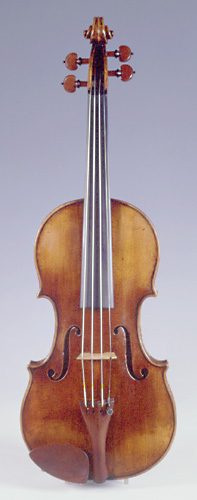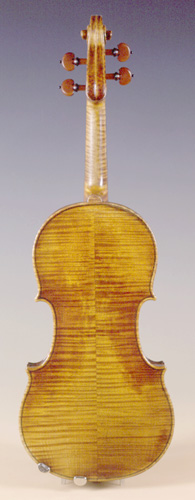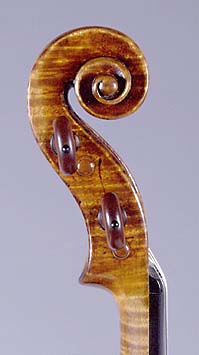 | Featured Instrument |
 | Featured Instrument |
 To be offered at auction at Phillips in London mid-November, 1996. Estimate £600,000-700,000.
To be offered at auction at Phillips in London mid-November, 1996. Estimate £600,000-700,000.
Antonio Stradivari was born in Cremona in 1644 and died there in 1737. He is acknowledged to have perfected the Luthiers' art, so ably devised and developed by amongst others, the Amati Family who were his precursors and mentors.
It seems probable that during the early part of his life when he was a journeyman in the workshop of Nicolas Amati, he was involved in the construction of musical instruments other than the violin as the number of extant examples from the period 1666 (the date of his first recorded violin maker's label) to 1680 is small but significant. Stradivari's original design for harps, lutes, mandolins, guitars and a tromba marina together with many patterns and moulds and certain of his tools are now part of the Dalla Valle Collection in the Civic Museum in Cremona. During this period known as "Amatise" he conceived and built inter alia, the 1672 contralto viola and the first of the ten known inlaid instruments, "The Lever du Soleil" of 1677.
In 1680 he moved with his growing family into his house in the Piazza San Domenico, Cremona, where he lived and worked for the rest of his life and with this improvement of circumstances came a change of emphasis in his work as from the above date he made many more violins and violoncelli than previously. Nicolas Amati died in 1684 and Stradivari's reputation as the pre-eminent violin maker of Cremona began to grow substantially both locally and beyond Cremona. In the ten years from 1680 his inclination to experiment and develop his skill took him in new directions away from those of Nicolas Amati. His instruments became bolder and more vigorous in certain areas, particularly the corners, producing greater tonal strength and quality.
 By 1690 Stradivari's restless innovative temperament began to challenge many of Nicolas Amati's canons. In their epoch-making book on Stradivari, published in London 1902, the Hills state: "... every ten or twelve years Stradivari was ripe for a change" and this decade was to prove one of the most radical. The heavier corners of instruments of the previous decade were complemented by wider purfling, bolder soundholes, stronger arching and a deepening colour of varnish applied with great discretion and artistry.
By 1690 Stradivari's restless innovative temperament began to challenge many of Nicolas Amati's canons. In their epoch-making book on Stradivari, published in London 1902, the Hills state: "... every ten or twelve years Stradivari was ripe for a change" and this decade was to prove one of the most radical. The heavier corners of instruments of the previous decade were complemented by wider purfling, bolder soundholes, stronger arching and a deepening colour of varnish applied with great discretion and artistry.
It is during this period that he conceived and built instruments known as "Long. Pattern" of which "The Baillot-Pommerau" of 1694 is a very fine example. As he narrowed and increased the length of instruments so he hoped to augment further the tonal depth, strength and quality and this may have arisen as a result of seeing and hearing examples of the work of the earlier Brescian School. Charles Beare, writing in Groves, says of these instruments: "These elegant violins, representing a huge improvement on everything that had gone before are not always as well appreciated for their tone as perhaps they should be".
Purely by chance our auction in November will also include a fine example of the Brescian School, a violin by G.B. Maggini of Brescia, circa 1620, made before Stradivari was born! This instrument was the property of Alfred E. Hill until his death. This will give those attending the sale and preview a chance to compare and contrast two giants of seventeenth century Italian Lutherie.
 The provenance of the Baillot-Pommerau is fascinating for what it suggests about nineteenth century social European history. It was originally acquired by Pierre Baillot (1771-1842) a contemporary of Niccolo Paganini. Baillot was amongst the first of the urban professional musicians who, as a result of their talents and in his case French political influence in the early nineteenth century, developed a local and international reputation. To some extent he established practices and procedures which later virtuosi followed and continue to follow. He was also one of the first professors at the recently opened Paris Conservatoire created with a view to developing and training future musicians and performers.
The provenance of the Baillot-Pommerau is fascinating for what it suggests about nineteenth century social European history. It was originally acquired by Pierre Baillot (1771-1842) a contemporary of Niccolo Paganini. Baillot was amongst the first of the urban professional musicians who, as a result of their talents and in his case French political influence in the early nineteenth century, developed a local and international reputation. To some extent he established practices and procedures which later virtuosi followed and continue to follow. He was also one of the first professors at the recently opened Paris Conservatoire created with a view to developing and training future musicians and performers.
Thereafter the instrument remained with the "forces of reaction" in aristocratic private hands for almost a century belonging to the Marquis de Pommerau and his family until the early twentieth century.
At the same time as Sir Joseph Duveen was building the great collections of old master paintings for the legendary American collectors of the early twentieth century like Morgan, Huntington, Frick and Mellon so this violin passed via Hills of London into, at various times, two of the most famous collections of musical instruments those of Baron Knoop and Richard Bennett.
As popular culture developed and financial and political upheavals followed World War I so the Baillot departed from the possession of connoisseurs into the world of commerce and the broadly established professional musician. It had to earn a living and so became the property of Arthur Catterall (1893-1943) whose famous concert career included leadership of the Halle Orchestra 1912-25 and the BBC Symphony Orchestra from its foundation in 1929-36.
Thereafter it was the property of another great musician Alfredo Campoli who had a great career in three continents and whose performances are still remembered to this day. Recently it has been back in private hands enjoying the occasional attentions of a devoted and gifted amateur player.
For further information see Phillips page
here on Maestronet or visit the main Phillips
Web Site
 |
 |
 |
 |
 |
 |
 |
 |